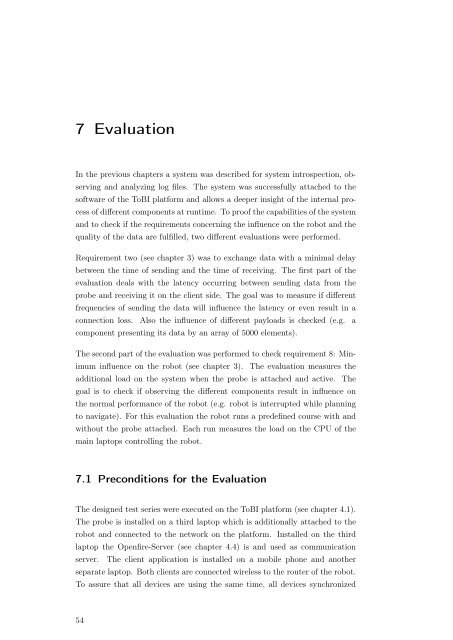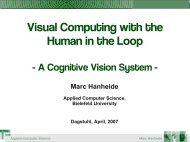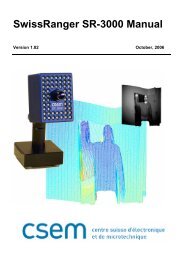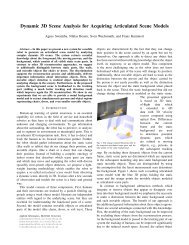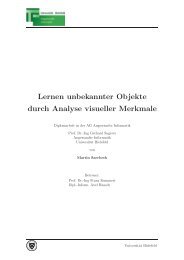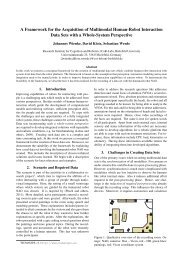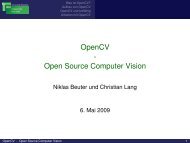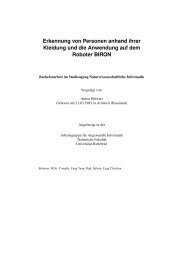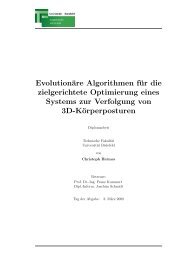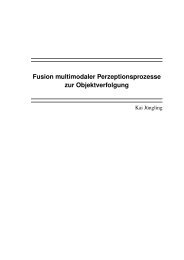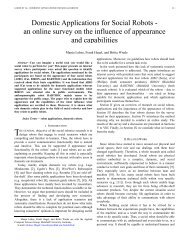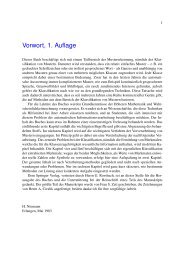System Introspection for System Analysis on Mobile Devices
System Introspection for System Analysis on Mobile Devices
System Introspection for System Analysis on Mobile Devices
Create successful ePaper yourself
Turn your PDF publications into a flip-book with our unique Google optimized e-Paper software.
7 Evaluati<strong>on</strong>In the previous chapters a system was described <str<strong>on</strong>g>for</str<strong>on</strong>g> system introspecti<strong>on</strong>, observingand analyzing log files. The system was successfully attached to thesoftware of the ToBI plat<str<strong>on</strong>g>for</str<strong>on</strong>g>m and allows a deeper insight of the internal processof different comp<strong>on</strong>ents at runtime. To proof the capabilities of the systemand to check if the requirements c<strong>on</strong>cerning the influence <strong>on</strong> the robot and thequality of the data are fulfilled, two different evaluati<strong>on</strong>s were per<str<strong>on</strong>g>for</str<strong>on</strong>g>med.Requirement two (see chapter 3) was to exchange data with a minimal delaybetween the time of sending and the time of receiving. The first part of theevaluati<strong>on</strong> deals with the latency occurring between sending data from theprobe and receiving it <strong>on</strong> the client side. The goal was to measure if differentfrequencies of sending the data will influence the latency or even result in ac<strong>on</strong>necti<strong>on</strong> loss. Also the influence of different payloads is checked (e.g. acomp<strong>on</strong>ent presenting its data by an array of 5000 elements).The sec<strong>on</strong>d part of the evaluati<strong>on</strong> was per<str<strong>on</strong>g>for</str<strong>on</strong>g>med to check requirement 8: Minimuminfluence <strong>on</strong> the robot (see chapter 3). The evaluati<strong>on</strong> measures theadditi<strong>on</strong>al load <strong>on</strong> the system when the probe is attached and active. Thegoal is to check if observing the different comp<strong>on</strong>ents result in influence <strong>on</strong>the normal per<str<strong>on</strong>g>for</str<strong>on</strong>g>mance of the robot (e.g. robot is interrupted while planningto navigate). For this evaluati<strong>on</strong> the robot runs a predefined course with andwithout the probe attached. Each run measures the load <strong>on</strong> the CPU of themain laptops c<strong>on</strong>trolling the robot.7.1 Prec<strong>on</strong>diti<strong>on</strong>s <str<strong>on</strong>g>for</str<strong>on</strong>g> the Evaluati<strong>on</strong>The designed test series were executed <strong>on</strong> the ToBI plat<str<strong>on</strong>g>for</str<strong>on</strong>g>m (see chapter 4.1).The probe is installed <strong>on</strong> a third laptop which is additi<strong>on</strong>ally attached to therobot and c<strong>on</strong>nected to the network <strong>on</strong> the plat<str<strong>on</strong>g>for</str<strong>on</strong>g>m. Installed <strong>on</strong> the thirdlaptop the Openfire-Server (see chapter 4.4) is and used as communicati<strong>on</strong>server. The client applicati<strong>on</strong> is installed <strong>on</strong> a mobile ph<strong>on</strong>e and anotherseparate laptop. Both clients are c<strong>on</strong>nected wireless to the router of the robot.To assure that all devices are using the same time, all devices synchr<strong>on</strong>ized54


